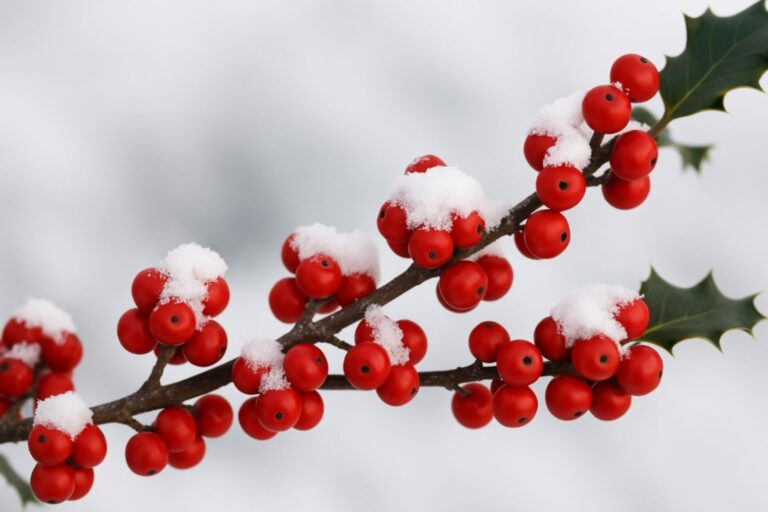December isn’t just the end of the year—it’s truly a whole mood. Cozy, reflective, joyful, a little chaotic (thanks, holiday season), and totally magical. And fittingly, the December birth flowers are a perfect pair to capture all that energy: holly and narcissus.
One is bold and evergreen, full of protective spirit and festive cheer. The other is delicate and quietly optimistic, a promise that spring is coming even when the world feels frozen. Together, they make a beautiful duo—just like December itself.
Whether you’re shopping for a meaningful gift, looking to learn more about your birth month blooms, or simply love a good flower story, you’re in the right place. Let’s get to know Holly and Narcissus a little better.
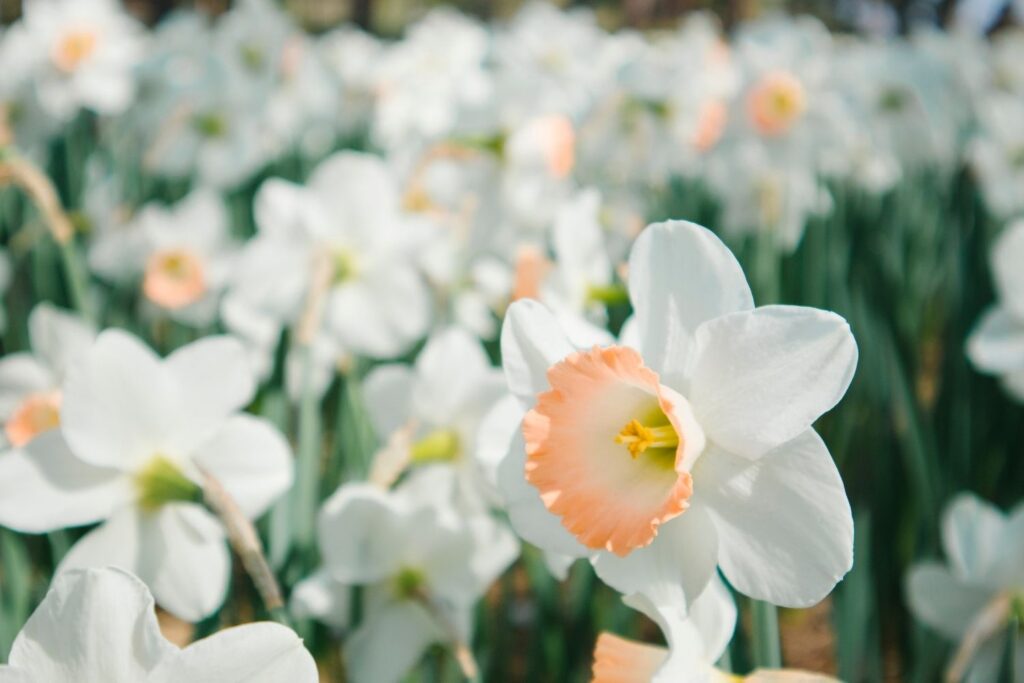
What Are Birth Flowers?
You know how birthstones give each month a bit of sparkle? Well, birth month flowers do the same—only with petals, color, and meaning. It’s one of those lovely traditions that ties nature and celebration together in the most personal way.
The idea has deep roots. In ancient Rome, flowers were given as birthday offerings to honor the gods and mark the passage of time. Fast forward to the Victorian era, and floriography—the language of flowers—took that idea further, assigning emotional messages to each bloom. Suddenly, your favorite flower wasn’t just pretty—it meant something.
Every month gets its own floral representative, sometimes even two. These aren’t random picks—they’re seasonal stars that also carry emotional weight. From January’s hopeful carnations to June’s romantic roses, each flower mirrors the mood of the month it represents.
And for December? The duo of holly and narcissus couldn’t be more fitting. One is bold and evergreen, full of festive spirit and ancient lore. The other is delicate and light, hinting at new beginnings just around the corner. Together, they capture the magic of a month that closes one chapter and opens another.
December Birth Flower: Holly
Brightening winter with its glossy leaves and cheerful red berries, holly stands as December’s festive birth flower. A symbol of protection, joy, and hope during the coldest season, this evergreen plant adds natural charm to holiday decor.
Holly: History and Symbolism
With its glossy green leaves and iconic red berries, holly has long been associated with winter celebrations and ancient traditions. But this plant’s story goes way beyond just holiday decor.
In ancient Rome, holly was linked to Saturn, the god of agriculture and time, and was used in the festival of Saturnalia—an event full of merrymaking and gift-giving that inspired some of our modern Christmas customs. For Celtic druids, holly symbolized protection and eternal life, often planted near homes to ward off evil spirits.
In the Christian tradition, holly became a symbol of Christ’s crown of thorns, with its red berries representing drops of blood—a more somber but deeply meaningful interpretation. Over time, it evolved into a plant associated with peace, goodwill, and resilience.
Today, holly plant symbolism reflects strength, endurance, and festivity. It’s a fitting emblem for December—bold, evergreen, and always ready to shine in the darkest days of winter.
Holly: Colors and Their Meanings
Holly might not offer a full color wheel, but it packs powerful symbolism into its signature seasonal look. The deep green leaves and bright red berries are instantly recognizable and steeped in tradition, making them just as meaningful as they are beautiful.
- Green leaves: Tough and evergreen, these leaves are all about resilience and eternal life—thriving even when everything else is asleep for winter.
- Red berries: Bold and eye-catching, they’ve long symbolized protection and vitality. In Christian tradition, they also represent sacrifice and hope.
- White or variegated leaves: These special varieties add a touch of elegance and can be seen as symbols of purity, peace, and celebration.
It’s a classic winter palette that never goes out of style—rooted in history and glowing with meaning.
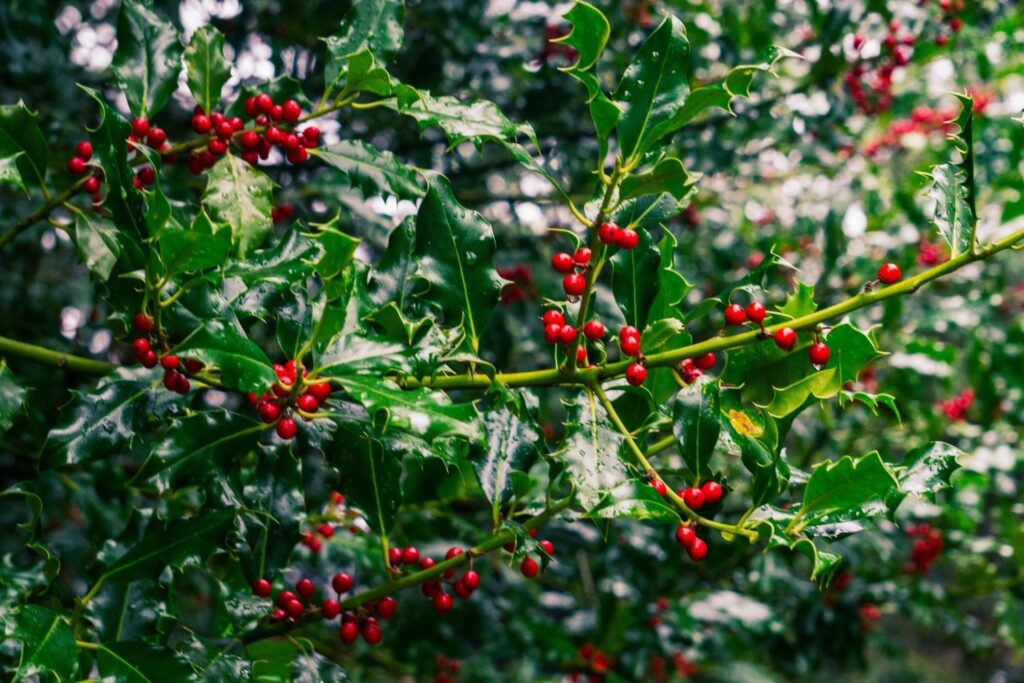
Holly: Growing and Caring
Thinking of adding a little holiday spirit to your yard or porch? Holly isn’t just a December icon—it’s a surprisingly low-maintenance plant that adds structure, color, and symbolism to your space year-round.
- Climate: Holly thrives in USDA zones 5-9 and holds its own through chilly winters. It loves full sun but can handle partial shade too—making it adaptable to a variety of garden spots.
- Soil: Aim for slightly acidic, well-draining soil. A little compost goes a long way in keeping your holly happy.
- Watering: Once established, holly is pretty drought-tolerant, but give it regular water in the beginning to help it settle in.
- Pruning: Prune in early spring to shape it up. And here’s a tip—only female holly plants produce those classic red berries, but they’ll need a male plant nearby to get the job done.
Whether you’re planting it outdoors or snipping a few sprigs for winter arrangements, holly brings that unmistakable December charm. And if you’re short on outdoor space, some compact varieties do well in containers too. It’s one of those plants that gives back in beauty far more than it demands in care.
December Birth Flower: Narcissus
Brightening the winter season with its delicate blooms, the narcissus emerges as December’s second birth flower. Symbolizing hope, renewal, and good wishes, this cheerful flower—often tied to the festive paperwhite variety—brings a touch of sunshine to holiday homes.
Narcissus: History and Symbolism
Narcissus might sound like a name out of a Greek tragedy—and well, it kind of is. But don’t let the dramatic origin story fool you—this bloom is more about rebirth and beauty than self-obsession.
According to Greek mythology, Narcissus was a young man so captivated by his own reflection that he couldn’t look away. Eventually, he transformed into the flower that now bears his name. It’s a story packed with symbolism, but the flower it inspired turned out to be quite the opposite of vain: delicate, hopeful, and bursting with meaning.
The meaning of the Narcissus flower varies across the world. In Chinese culture, it’s seen as a symbol of prosperity and good fortune, especially during the Lunar New Year. In the West, it often represents renewal, new beginnings, and quiet strength. It’s the kind of flower that whispers, “Hang in there, spring is coming.”
For December babies, it’s a beautiful message: even as the year winds down, there’s still fresh energy and light ahead. A fitting bloom to wrap up the calendar—and open the door to something new.
Narcissus: Unique Characteristics
Narcissus is a bit of a showoff—in the best way possible. These flowers are endlessly charming, and their range of forms and scents means they’re just as comfortable brightening a garden as they are sitting pretty on a winter windowsill.
- Varieties: Beyond the classic yellow daffodil, narcissus includes a variety of shapes and styles—from bold, trumpet-flared blooms to soft clusters like the beloved paperwhite.
- Colors: They show up in whites, yellows, soft peaches, and pale pink. Each hue brings its own subtle vibe—cheerful, graceful, or quietly elegant.
- Fragrance: Some are shy on scent, but others—especially paperwhites—offer a sweet, unmistakable perfume that fills a room.
With their versatility and charm, narcissus easily earns its spot as a winter favorite. And if you’re growing narcissus indoors, paperwhites are your go-to. They’re low-effort, fast bloomers, and a lovely reminder that spring isn’t so far off.
Narcissus: Growing and Caring
Narcissus might look delicate, but don’t be fooled—these blooms are tougher than they seem. In fact, they thrive with very little fuss, which makes them perfect for both novice gardeners and seasoned plant lovers.
- Planting: Get those bulbs in the ground in fall—about 6 inches deep. That gives them enough time to settle in before winter and pop up with flair come spring.
- Sunlight: Narcissus loves a sunny spot, but they’re flexible. Partial shade works just fine, especially in warmer climates.
- Watering: They don’t like wet feet. Water them after planting and let the winter rains do their thing. Once established, they’re fairly drought-tolerant.
- Indoor care: Want a splash of green indoors? Try paperwhites. Pot them in a shallow container with pebbles and just enough water to touch the roots. Keep them in a cool, bright room and they’ll bloom in 4–6 weeks, bringing brightness right to your windowsill.
These blooms are a breath of fresh air in the colder months—low maintenance, visually charming, and always a reminder that brighter days are just ahead.
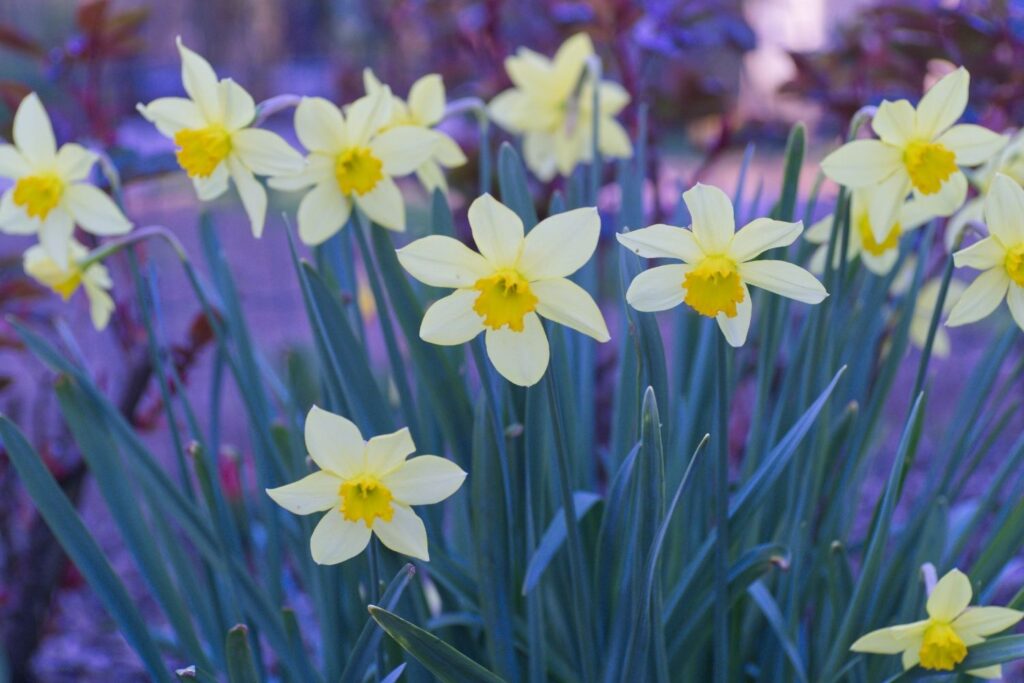
How to Use December Birth Flowers
Embrace winter’s magic with December’s birth flowers—holly and narcissus. Together, they blend festive tradition with hopeful new energy, perfect for seasonal centerpieces, wreaths, or meaningful gifts that celebrate the spirit of the season.
1. In Bouquets and Arrangements
Pairing holly and narcissus in a bouquet might not seem obvious, but it works beautifully. The bold structure of holly, with its vibrant green and red, contrasts perfectly with the softness of white or yellow narcissus.
Whether you’re crafting a winter centerpiece or sending flowers for a December birthday, this combination brings together festive charm and a breath of fresh hope.
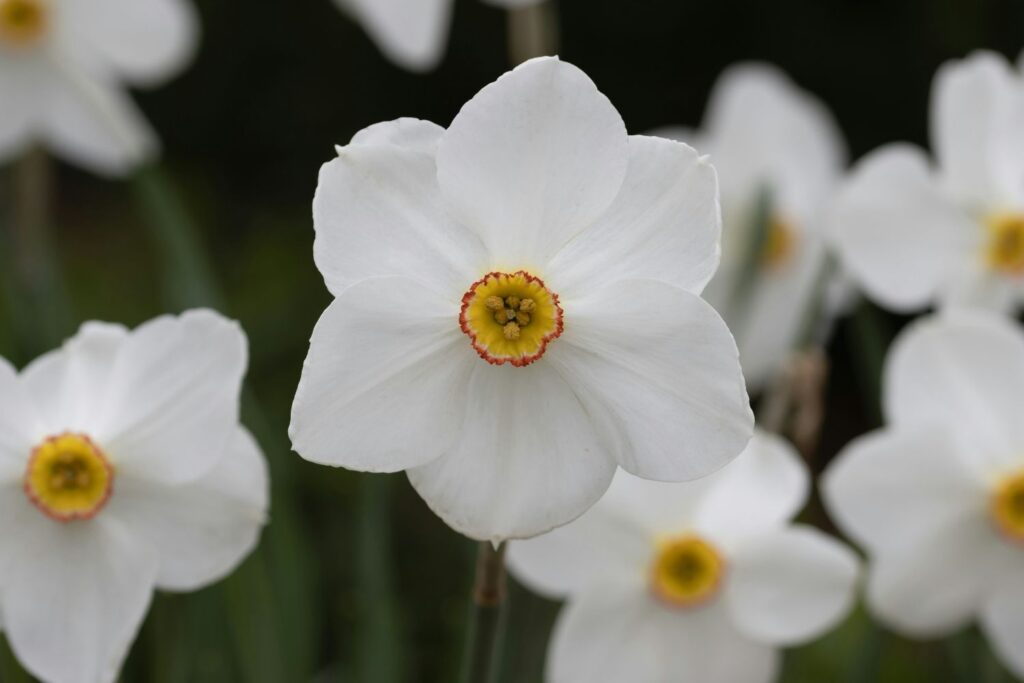
2. As Gifts
Looking for meaningful December birth flower gifts? Consider:
- A bouquet of paperwhites in a glass vase
- A potted holly shrub in a decorative planter
Jewelry or stationery featuring floral motifs
These thoughtful, symbolic gifts say more than just “happy birthday”—they celebrate protection, joy, and new beginnings.
3. In Home Decor
It’s no surprise that holly shows up everywhere in December—on wreaths, garlands, and mantels. But don’t forget about narcissus. A few blooming paperwhites add elegance and fragrance to winter tables or windowsills.
Mix the two for a blend of rustic and refined, cheerful and calming.
Fun Facts About December Birth Flowers
- The holly plant is dioecious, meaning male and female flowers grow on separate plants. You’ll need both nearby to get berries.
- In Norse mythology, holly was believed to bring protection from lightning.
- Narcissus is one of the first flowers to bloom in spring, even pushing through snow in some regions.
- Paperwhites (a type of narcissus) can bloom indoors without soil—just water and pebbles.
- The narcissus is the national flower of Wales and is traditionally worn on St. David’s Day.
- Holly berries are toxic to humans and pets, so admire them—but don’t snack on them.
- Want a meaningful tattoo? December birth flower tattoos featuring holly and narcissus symbolize resilience and renewal—a beautiful blend for marking personal growth.
- In floriography, a single narcissus bloom can mean “you are the only one.”
Conclusion
Holly and narcissus might come from different corners of the floral world, but together, they tell a story that’s uniquely December—festive, enduring, and full of hope.
If you’re celebrating someone born in this magical month, or simply want to embrace the season’s deeper symbolism, these blooms are a beautiful way to do it. Pair them with candles, greenery, or a handwritten note, and let them speak for you.
Because, whether it’s the boldness of holly or the quiet promise of narcissus, the December birth flower captures something we all need this time of year: warmth, protection, and the joy of something new on the horizon.

